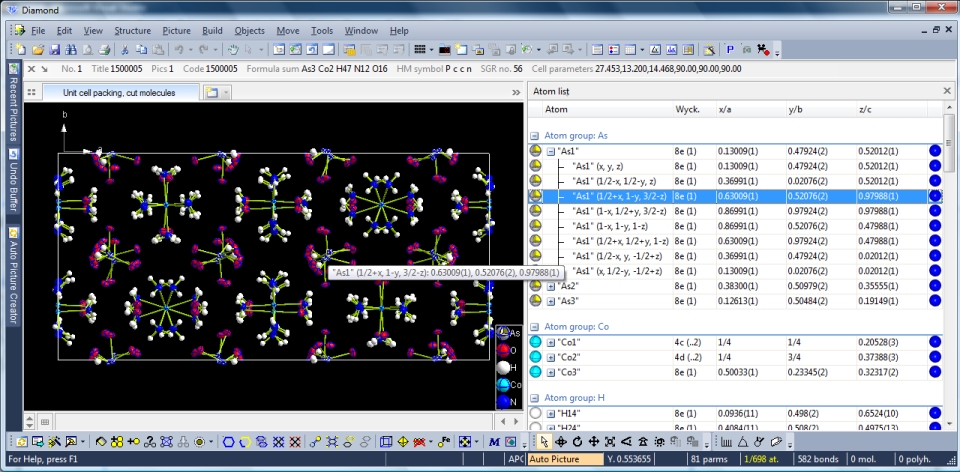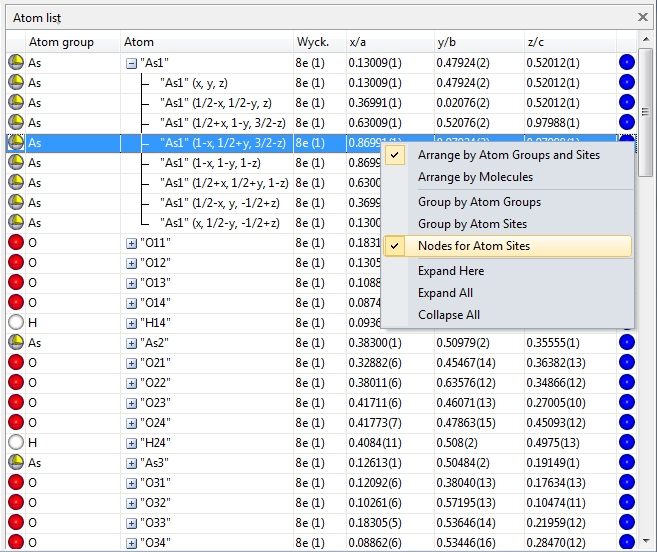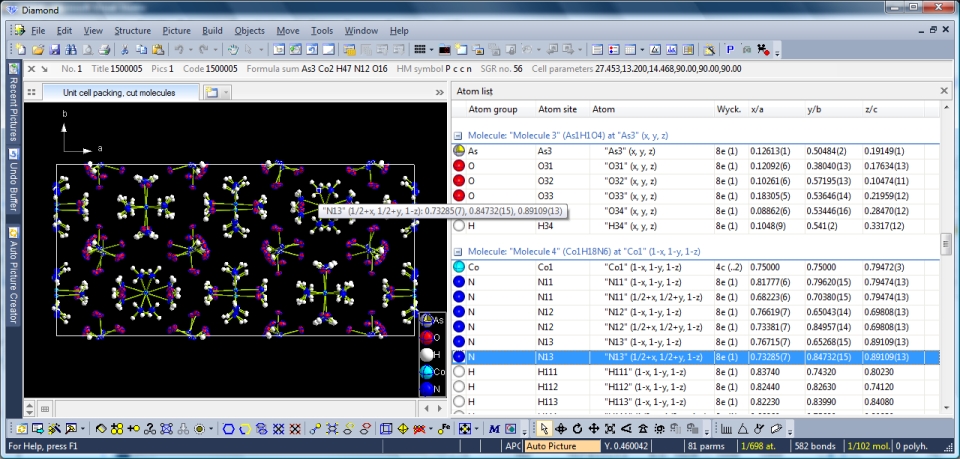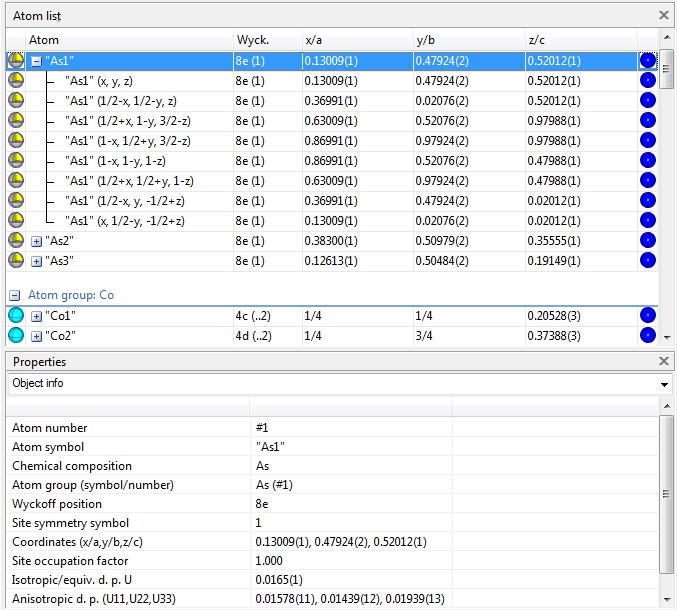Atom List
The atom list is a hierarchical list of atom groups, atom sites, and created atoms of a structure picture --
or a list of molecules and their constituent atoms
The atom list in brief:
- Used for instance to edit properties and designs or to select from.
- Two kinds of arrangements: 1) For atom groups, sites and created atoms. 2) For
molecules and their constituent atoms.
- Settings, if and how to group items.
- Plus/minus signs (and commands) to collapse or expand trees of items.
- Preview of atom design in first column.
Previous article: Tables of objects like atoms, bonds, molecules etc.
Next article: "Grab mode": New mode for more intuitive rotation, shifting or zooming during exploration of a crystal or molecular structure
A special kind of table is the "Atom list", which either shows all atom groups and their
atom sites as well as their associated (symmetry-equivalent) atoms currently in
the structure picture or all molecules and their constituent atoms. It contains informations from both table of atomic parameters,
created atoms, and atom groups as well as from the table of created molecules in one table. Unlike the mentioned tables of atomic
parameters, created atoms, etc., the atom list uses several options to group or
indent items.
To show the atom list in the data pane right beneath the structure picture pane,
use the command Atom List from the View menu.
Or simply click the corresponding button in the main toolbar.

Note: Screenshots in this article have been made with Diamond version 4.
Atom groups, atom sites, and created atoms
The default setting uses the hierarchy of atom groups and their associated atom
sites as well as the associated created (symmetry-equivalent) atoms present in the
current structure picture. This hierarchical list gives you enhanced access to single or some atoms or some or all
atoms of a site or group, e.g. to edit properties and designs or to select them.
To see an atom list like in the following screenshot, open the sample file "COD-1500005.diamdoc".
A selection in one of the created atoms in the atom list (i.e. third or lowest level
in the hierarchy of atom groups, atom sites, and created atoms) is automatically
reflected in the structure picture. (The mouse cursor was moved to "As1" at 1/2+x,
1-y, 3/2-z to show the info tip.)

Screenshot of Diamond with atom list arranged by atom groups and sites (COD:1500005)
The context menu of the atom list offers options to group (or not) on atom group
and/or atom site level. If you neither group for atom groups nor atom sites and
disable the nodes for atom sites, the atom list behaves similar to the well-known
table of created atoms -- and shows additional columns for atom group and atom site
left of the created atom column. The last group of commands helps you expand or
collapse single or all items.
Atom list not grouped for atom groups but with nodes for atom sites, and only site
"As1" expanded
Molecules and their constituing atoms
An alternative hierarchy is to group the atoms of the structure picture for symmetry-equivalent
molecules and the molecular unit(s) that have been derived from the atomic parameter
list involving the current bonding sphere settings (connectivity) or atomic environments.
It shows all molecular units and their constituent atoms -- whether
they are present in the structure picture or not (yet). (That means, in an empty structure picture,
you will have at least the molecular units, derived from the atomic parameter list
and their consituing atoms in the atom list -- the "Molecule n" at "Ref.atom" at
x,y,z.)

Screenshot of Diamond with atom list arranged by molecules and 'N13' at 1/2+x, 1/2+y,
1-z highlighted, which is part of 'Molecule 4' with reference atom 'Co1' at 1-x,
1-y, 1-z (COD:1500005)
Atom design preview
Regardless of hierarchical list of atom groups, atom sites, and created atoms -
or molecules and their constituing atoms - the leftmost column previews the design
of the atom. The properties pane under the atom list (run "View" -> "Properties"
to show, maybe you have to shift the divider between atom list and properties view
manually up) shows the properties of the currently highlighted atom group or atom
site or created atom or molecule.

Screenshot of atom list of COD:1500005 with atom site 'As1' highlighted and properties
shown in the properties pane below
Previous article: Tables of objects like atoms, bonds, molecules etc.
Next article: "Grab mode": New mode for more intuitive rotation, shifting or zooming during exploration of a crystal or molecular structure
Reference:
COD:1500005: Hexaammine cobalt(III) hydrogenarseniate tetrahydrate; Ritu Bala,
Raj Pal Sharma, Rajni Sharma, Juan M. Salas, Miguel Quiroos, William T.A. Harrison;
Journal of Molecular Structure, 828, 174-180 (2007).
|

